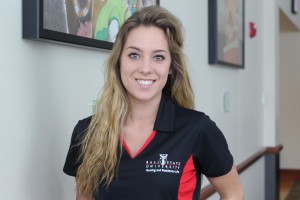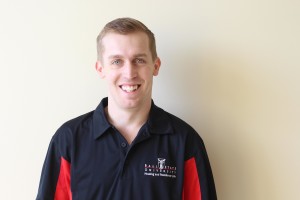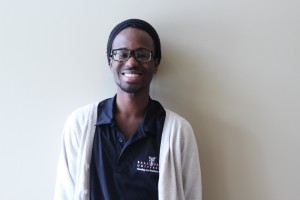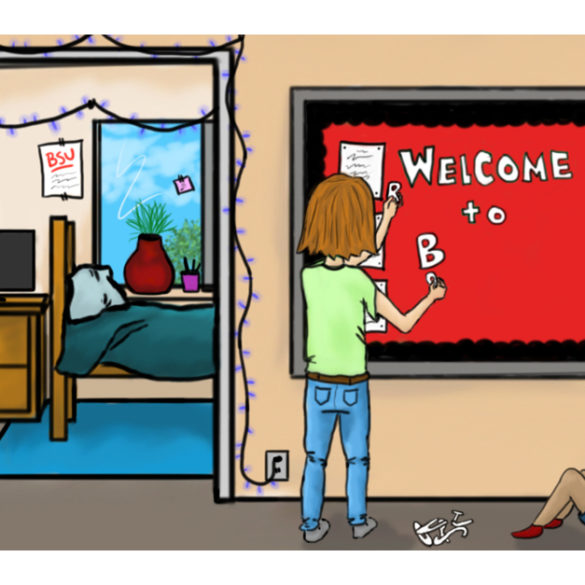Student life as a resident assistant can be challenging but also comes with unseen rewards.
Right from the start, it was go, go, go. Waking up in the early morning with light peering into the big window in the room, my day started at 9:00 a.m. There was a slight chance of a break. Just enough time to choose one option: to take a nap, to take a shower, or grab lunch.
At the end of the day, I stumbled my way down the long, hot hallway of my building, opened the door, walked into my room, set my keys on the small white command hook attached to the wall, set the backpack on my bed and then I heard it. Knocking at my door.
Who could that be….
Slowly opening the door, a resident was standing there with the biggest grin on his face.
“Hey man, how are you doing?” he asked me.
“I am doing well,” I said, my typical response. But I was not well. I was tired, hungry, and wanted to just curl in my bed and forget about the world.
After the resident shared his exciting news, he paused, looked at me and asked if there was something wrong. “You don’t seem yourself.”
He was one of my residents I was closer to on the floor. It had been a long day and I needed to remind myself this was an all-hours job. “Oh, I am sorry,” I told him.
Before leaving for his room, he turned around, looked at me and said. “Caleb, because of you, I have become a better person.”
In the middle of my busy routine, moments like this reminded me why I took on the job of Resident Assistant.
When the name Resident Assistant (or RA for short) comes to mind, there are several stereotypes. From the RA who quiets you down in the afternoon for being too loud, to the RA who plays video games with you, and to the RA who is never there.
As RAs, we are told: “You are a student first and a RA second.” But when does that line become blurred?
I am not alone in this experience–there are hundreds of other RAs around the country and on Ball State’s campus. Sam Johnson is a sophomore telecommunications major and is in her first year as an RA in Park Hall.

She works with a diverse community in her wing. With that community, she wants to make sure she was accommodating everyone and doing her job well. She wanted an inside opinion.
At the end of the semester, Sam emailed a survey to all of her residents.
She asked them to be completely honest as they answered the questions in the email:
Am I present? Am I doing programs right? Do you like my bulletin boards? What do you think I can do better?
The forms were turned into Sam anonymously later that week.
What stood out to her were the residents she had barely seen in the last semester who acknowledged and appreciated the work she has done as a first year RA.
The moment after reading those surveys, Sam became overjoyed. Immediately, she texted her Assistant Hall Director.
Her Assistant Hall Director replied, “I told you were doing well.”
“I am really making a difference,” she thought.
RAs get to see the roller coaster residents go through. They see the good and the not so good. RAs go through things most would not.
Adam Kuban, a professor of journalism at Ball State, was a former RA when he was an undergraduate at Iowa State University. He was an RA for three years, however, one of his biggest moments as an RA came his second year.

It was a warm, sultry weekend in mid-April of 2004. Iowa State was celebrating a tradition, the Veishea Festival.
The Veishea Festival was an annual Spring celebration that has been celebrated by the university. Veishea was an acronym that stood for the original colleges that formed the university. It was the Veterinarian College, the Engineering College, the Industrial Science College, the Home Economics College and the Agriculture College.
There was tradition behind the celebration and during the day, people could enjoy the wonders of the festival. However, at night, the atmosphere turned.
When the sun went down, students went out to parties. There were even more students this night–twice the amount of students from surrounding colleges.
That night, as the students were going out, Adam was on duty with more than the usual amount of RAs.
“We were watching an Indiana Jones Marathon when we got a call on our pagers for a student disturbance,” said Adam.
A half hour before that moment, chaos filled the streets.
After several parties were broken up by the police, the students filled the streets of what we know as The Village.
As the drunk crowd filled the streets, the police already knew what kind of crowd it would be due to previous years experience.
Upon seeing the police in the streets, the drunk crowd became angry. People in the crowd picked up rocks and threw them at the police and at store windows that were already closed for the night breaking them.
To the crowd, destruction was the best option. They made street lights, sway back and forth until they broke off from the ground they were bolted to. They tipped over cars.
Finally, the police had enough. BOOM! A cloud of smoke filled parts of the streets. Tear gas was thrown into the crowd. In less than a second, the streets were filled with people crying, screaming, and panicking.
Back in the building, Adam approached a resident by the main doors who was hysterical. The resident was uncontrollably crying and the RAs were confused.
At that same moment, the RAs heard panicked residents coming from inside the building.
Not all residents went out that night. The residents who did not go out went to bed and the ones who did, did not have air conditioning and opened their windows. A street away from the building, the smoke cloud started to move toward the residents with the open windows.
One by one, residents woke up, panicking due to the uncontrollable tears going down their faces.
Residents got up screaming for someone to help them. Adam, along with the other RAs, was affected by the smoke. Through blurry eyes, coughing and being disoriented, the RAs quickly moved around the building taking stations to make sure the building was safe.
Adam ended up helping the resident who came in to relieve their crying. That night, no one got any sleep.
Most RAs won’t have to deal with what Adam did. However, there are cases where RAs have to be ready at a moment’s notice. What keeps them going is the motivation for the job.
James Myers, a senior accounting major who was an RA for his sophomore and junior years in LaFollette wanted one goal for his job. Throughout life he has always had the same mission that he follows. That mission is to reach out to as many people as he can on a daily basis to impact them in a positive manner. Becoming an RA gave him a perfect opportunity to follow through with this mission.

Abe Robinson, an RA in Dehority Complex, was having a rough week last semester. A week filled with back-to-back meetings and classes. Waking up in the early morning’s for his classes all day going straight to rehearsals then meetings until not being completely finished until close to midnight.
The week was dragging on and Abe wanted it to be over. Making his way through the lobby, a resident by the front desk stopped him. Now, this was not one of Abe’s residents and he barely saw her in the building.
Automatically, she said: “You are the reason I came to Ball State.”
Abe was confused. “What do you mean?”
The resident was a freshman and at the end of a tour of campus from the previous year, she met Abe.
He gave the family a tour of his room.
He showed her how the room could be set up and what could be included in the room.
At that tour, Abe expressed his love for Ball State and by that, the resident chose Ball State.

Abe was shocked after hearing that story. “That was a ‘wow’ moment for me,” he said. Abe was thrilled that he was able to meet her needs and make that big of an impact on one person.
One afternoon while I was on duty, there was a fire alarm that went off. This was nothing out of the ordinary.
However, in any given fire alarm/drill, all the residents, RAs, Hall Directors, and desk staff leave the building and meet in one spot. The RAs separate by floor and check off a list to see where their residents are. At that moment, when everyone was outside, three out of the eight RAs sprang into action.
Calling all the names on the list and asking where the other residents were, I moved on to the next floor. Each RA did that, helping where it was needed
RAs are there to support one another. They create their own community. Through it all, an RA is there to be that resource, support, mentor, and friend for their residents. Not every resident is the same, so the RA goes about the approach through multiple angles. They accommodate to that resident’s needs.
Although there are difficulties to balancing student life with duties as an RA, I chose this job to help residents and be a resource to them.




